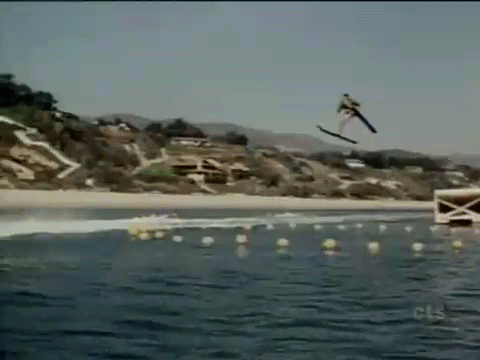This rather long post explains how you can make images and animations like the ones below using only open source software (mostly QGIS) and open data. I've just used flights from Hartsfield-Jackson International Airport in Atlanta because it's the busiest airport in the world and serves a wide variety of destinations. The methods are relatively straightforward but it does take time to get your head around if you're new to the software and the data. If you're already a competent QGIS user it should be pretty easy. Once you've got the method nailed down you can apply it to all kinds of different scenarios and datasets. First of all, though, here's a static image of outbound flights from ATL projected onto a globe.
 |
| Flight destinations from Atlanta (full size) |
The first thing you'll need to do is get some data. In this example I've taken some general country boundaries from Natural Earth and for the flights data I've used the OpenFlights dataset. I then created an azimuthal orthographic projection centred on Hartsfield-Jackson International Airport in Atlanta. Hamish Campbell already wrote an excellent tutorial on how to do this in QGIS, so just follow that if you want to use a projection that makes your country layer appear as if it were on a globe. The only extra tips you'll perhaps need to replicate Hamish's method are as follows. To get the lat/long of a place you want to centre your projection on, just search for it on Google Maps and then look in the address bar for the coordinates. The python script on Hamish's page just needs to be copied and pasted into a text document, saved with a .py extension and then placed in the correct folder on your computer (on a PC with QGIS 2.4 it would be something like this: C:\Program Files\QGIS Chugiak\bin). Also, when you clip the layer to a global projection, QGIS will create a clip circle and a new clipped layer. These may not appear at all or if they do they'll maybe be very blocky. If so, go to the properties for the layer in QGIS and on the Rendering tab just untick 'Simplify Geometries'. I normally save new copies of these layers using Save As... from each layer.
 |
| A faster animated version of ATL outbound flights (big) |
That should be your global projection sorted. You can then apply it via the Project menu in QGIS and then Project Properties... CRS and then 'Project on the fly' as in the tutorial. To achieve some of the visual effects above, I just duplicated the clipped circle layer (you'll have to Save As... from the temp clipped layer to do this) and applied an inverted polygon style and a shapeburst fill with a blue to black gradient (Nyall Dawson did a great blog post on this, which you might find useful). I also did a similar thing with the land layer, just to make some of the smaller islands stand out. You'll also need to make the outline colour the same as the fill colour in the circle to avoid a line appearing through your earth.
 | |
| A very slow version, with a pause at the end (big) |
So far, so good. But what about the flight paths and animated dots? Well, to create the lines you can follow my blog post on flow mapping in QGIS and use the sample dataset I posted there. You'll need to calculate two new columns for this shapefile (see below) and use the MMQGIS plugin for QGIS (installed, as ever, via the Plugins menu). If you just add this file to your global azimuthal orthographic projection there will be so many lines and it may take a long time to display so there are a few intermediate steps I'd recommend...
1. Open the new global flights dataset in a blank QGIS project using the default projection and then remove duplicate lines using Modify, Delete Duplicate Geometries in the MMQGIS plugin. Many routes (e.g. JFK-LHR) are served by multiple airlines and I wanted to only show origins and destinations. This also makes the file much smaller. 2. Although the flight connections would appear as straight lines on our global projection, I like them to look a little curved; partly for effect and partly to bring out the curvature of the earth but also because flight paths are not straight lines in reality. So, once I've removed duplicates I then 'densify' the lines in QGIS by adding in 50 intermediate vertices - done via Vector, Geometry Tools, Densify polygons in QGIS. 3. I then added this new flights layer to my ATL-based global projection and I clipped the layer using the Hamish Campbell method, and saving the resulting layer as a new shapefile. You should now have a globe centred on the location of your choice, plus some nice curved airline flight paths.
 |
| Same as above, but with labels and pause at end (big) |
For the next stage, the way I did it was to open the dbf part of the new flight paths shapefile in Excel and then calculate an 'offset' lat and long column which I could use to animate the dots. You just need to read the Animate Columns part of Michael Minn's MMQGIS page to understand this. Once you've calculated the new lat/long offset columns you can save the csv. Once you've done this, import the csv into QGIS using the Add Delimited Text Layer (comma icon), using the airport origin lat/long as the x,y coordinates in the import dialogue. Filter the new layer so it only shows ATL origins and you'll just see one dot for ATL but actually there are many dots in the same location as they all have the same origin lat/long. Save the filtered layer as a new shapefile and then run the Animate Columns tool in MMQGIS using the appropriate fields and the number of animation frames you want (50 works well with this example). An important point here is that you need to make sure your QGIS window is quite small as the extracted image frames will be the same size as your QGIS map frame and if it's too big it will make a massive GIF.
You now have all you need to create an animation. There are many ways to create an animated GIF, but using GIMP is very simple. You can download this free, open source image manipulation programme in a few minutes. You then just need to go to File, Open as Layers and then select all the frames you just created in QGIS and GIMP will add them to the project and they'll appear in the Layers pane. You don't need to reorder them as they are numbered correctly from the MMQGIS export. From here you can go to File, Export and then select the GIF file format and use the animation options here. Try 50 milliseconds between frames as with 50 frames this will create a nice short 2.5 second animation that isn't too slow. You should use Filters, Animation, Optimize for GIF and then export from that window if you want a much smaller file size. I created another one of these visuals, centred on LHR and showing flows from JFK, LHR and PEK.
That's quite a lot of information and quite a few steps but if you try this and still can't make it work feel free to get in touch via twitter or e-mail. Why would you want to do this? I'll leave that up to anyone who wants to try it but displaying movements of people and goods is relevant across a number of disciplines so hopefully some will find this useful.
Other tips and information: depending upon which location you're choosing, some of your lines or dots might be going the wrong way round the earth but you can fix this with a bit of simple maths in the offset calculation. In GIMP, you can add a different frame duration by adding a number and then ms to the layer info - e.g. 1000ms - so that it creates a pause effect, as in the examples above. I created an ATL point and a destination airports points layer from the imported csv so that I could manually create a couple of extra frames to add in to the end of my animation. One to show destinatinon airport names and the other just to label ATL. For the glow effect in the flow lines in the static image I used the Feature Blend 'addition' option in layer properties in QGIS.
Acknowledgements: As ever, I've borrowed ideas and techniques from other QGIS users, including Hamish Campbell, Nyall Dawson, Nathan Woodrow. I decided to have a look at this after an e-mail exchange with Waldo Tobler about migration data. Thanks of course to the excellent OpenFlights team who make their data available under an Open Database Licence.
You now have all you need to create an animation. There are many ways to create an animated GIF, but using GIMP is very simple. You can download this free, open source image manipulation programme in a few minutes. You then just need to go to File, Open as Layers and then select all the frames you just created in QGIS and GIMP will add them to the project and they'll appear in the Layers pane. You don't need to reorder them as they are numbered correctly from the MMQGIS export. From here you can go to File, Export and then select the GIF file format and use the animation options here. Try 50 milliseconds between frames as with 50 frames this will create a nice short 2.5 second animation that isn't too slow. You should use Filters, Animation, Optimize for GIF and then export from that window if you want a much smaller file size. I created another one of these visuals, centred on LHR and showing flows from JFK, LHR and PEK.
 |
| Same techniques, different data (and also a bit crazy) |
That's quite a lot of information and quite a few steps but if you try this and still can't make it work feel free to get in touch via twitter or e-mail. Why would you want to do this? I'll leave that up to anyone who wants to try it but displaying movements of people and goods is relevant across a number of disciplines so hopefully some will find this useful.
Other tips and information: depending upon which location you're choosing, some of your lines or dots might be going the wrong way round the earth but you can fix this with a bit of simple maths in the offset calculation. In GIMP, you can add a different frame duration by adding a number and then ms to the layer info - e.g. 1000ms - so that it creates a pause effect, as in the examples above. I created an ATL point and a destination airports points layer from the imported csv so that I could manually create a couple of extra frames to add in to the end of my animation. One to show destinatinon airport names and the other just to label ATL. For the glow effect in the flow lines in the static image I used the Feature Blend 'addition' option in layer properties in QGIS.
Acknowledgements: As ever, I've borrowed ideas and techniques from other QGIS users, including Hamish Campbell, Nyall Dawson, Nathan Woodrow. I decided to have a look at this after an e-mail exchange with Waldo Tobler about migration data. Thanks of course to the excellent OpenFlights team who make their data available under an Open Database Licence.

















